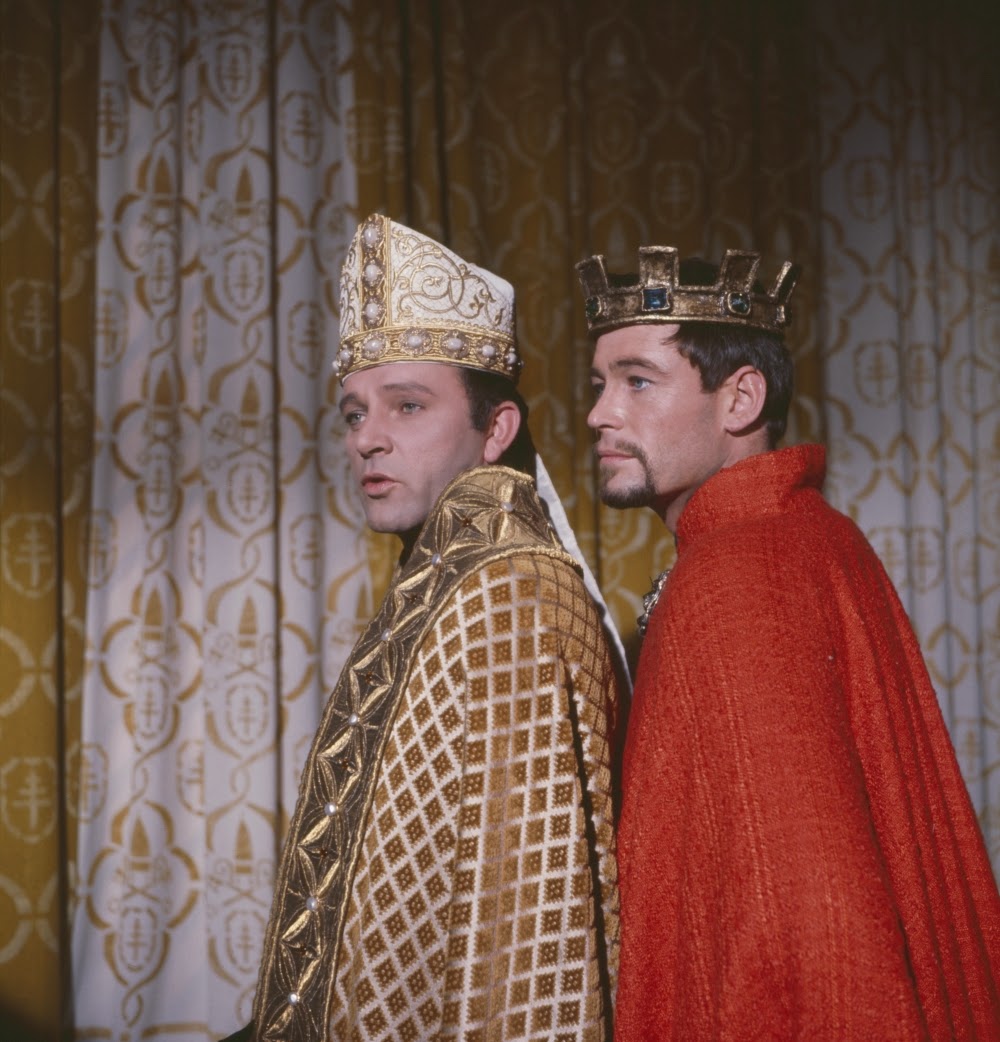 |
Richard Burton as the Archbishop of Canterbury with
Peter O'Toole in the role of King Henry II in the
1964 Paramount Pictures movie of Becket.
The cope worn by Richard Burton is in part based
on actual vestments of Saint Thomas Becket;
the curtains in the background have a Papal monogram:
the triple tiara and crossed keys. |
Typically, whenever the rites of the Catholic Church are depicted on the big or small screen, they are represented inaccurately (sometimes laughably so), or even sacrilegiously. An exception to this is the very fine 1964 movie "Becket" produced by Paramount Pictures, and starring the late Richard Burton in the role of Saint Thomas Becket (1117 - 1170), once Chancellor of England and subsequently Archbishop of Canterbury.
This post is not about the life of the Saint, but rather about aspects of the presentation of the rites of the Church depicted in this movie. We find that production design for this movie was in the care of John Bryan; art direction by Maurice Carter; set decoration by Robert Cartwright and Patrick McLoughlin with costume design by Margaret Furse. These people obviously researched the rites and vesture of the Church in the early Mediaeval period quite carefully.
A search of the internet has uncovered some interesting stills of this movie, which are shewn here, together with some commentary. Largely they depict that scene where Becket is consecrated as Archbishop of Canterbury. An interesting description of the Consecration is given
here .
Click on the following images for an enlarged view.
 |
At the Profession of Faith.
The consecrating bishop is vested for Mass in full pontificals.
The co-consecrators are vested in matching copes and mitres.
Surrounding the prelates are deacons vested in dalmatics
and young acolytes some vested in albes, some in surplices.
Amice apparels are everywhere. |
 |
At the Laying-on of hands.
A detail of the ornamentation of the cope used in the production.
The ornamentation is accurately based on a stole of Saint Thomas
still housed in the Sens Cathedral. |
 |
Imposition of the mitre.
The mitres worn are all accurate reconstructions of mitres
worn in the 12th century.
They are small, and their titulus and circulus ornaments are
enriched with jewels. |
 |
After the Imposition of the mitre.
A specially printed impression of the Pontificale Romanum
prepared for the movie is seen here. |
 |
The well-designed and finely-worked ornamentation
of all the vestments can be seen here.
Note the blue stole worn by the co-consecrator. The practice of having all
the vestments worn by a celebrant of the same colour is not an ancient one. |
 |
At the Enthronement.
The new Archbishop, now dressed in full Pontificals for Mass,
is also wearing the pallium: a fine interpretation of the mediaeval form.
Also clearly seen are the fringed dalmatic and tunic
worn by the consecrating bishop.
We must also take note of the beautiful Western-style iconography
created as a backdrop for the Archbishop's throne:
vigorous and very religious in feeling. |
 |
The Final Blessing of the Mass of Consecration.
We are able to see the altar in this photograph, ornamented with
images of the saints and with a tabernacle resting upon it.
This would seem to be the least accurate aspect of this scene from the movie. |
 |
| The Final Blessing, somewhat over-dramatically depicted. |
 |
Years after the movie was made,
the costumes designed by Margaret Furse for Richard Burton's use were auctioned.
This photograph shews the chasuble and dalmatic, with an amice apparel.
The chasuble is a rather free redesign of the famous Becket chasuble
kept even to this day at Sens Cathedral. |
 |
The actual chasuble of Saint Thomas Becket,
housed in the treasury of Sens Cathedral.
This image is the copyright of Genevra Kornbluth. |
 |
A 19th century engraving of the mitre, chasuble and stole of Saint Thomas
venerated at Sens Cathedral.
These vestments were carefully studied for reproduction in the Paramount movie.
The ornamentation of the ancient stole was replicated as the ornament of
a cope and amice apparel used in the movie, whilst the ornament
of the mitre (see below) was used as the basis for several mitres in the production. |













